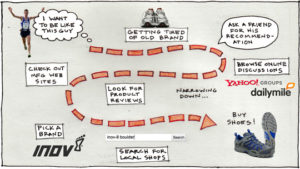There is a basic problem with web analytics today. Web analytics tools give us data on what drives leads or web conversions, but the picture they paint is incomplete at best and can be misleading. As an illustration, below is a cartoon describing my own experience deciding on and purchasing a new brand of trail running shoes. This cartoon more or less follows the path I really took, from when I was first motivated to look for a new brand to when I actually purchased.
Along my meandering path, I had many opportunities to interact with brands and retailers. You’ll also notice that word-of-mouth played heavily into my decision. And this is not just anecdotal – there is a lot of research to support the fact that most purchasing decisions are heavily influenced by word-of-mouth. Also, my cartoon illustrates the interactions I remember – but there are many brand and business interactions I don’t remember. For example, several local retailers are very active in the local running community, including online forums. I tend to think of those businesses as authoritative, even if they are not speaking directly to my current interest. There are also race and athlete sponsorships that create a positive association with brands, even if I don’t consciously remember them.
The lesson here is that much of what happened prior to my purchase was not directly measurable. In fact, if someone were measuring, they would probably think that search advertising or organic ranking accounted for my purchase, but I had all but made my decision at that point. Online reporting tools are good at measuring search clicks, but not so good at measuring everything else that happened prior to that last search.
There are some reporting tools that do a better job than others of measuring all of the interactions that lead to a conversion. I’ve found both Atlas Institute (note 5/2017: no longer online) and Omniture Discover to be very useful when trying to understand buyer behavior, but both of these are too expensive for small businesses. Unfortunately, Google Analytics does a poor job at this even though it is a very powerful tool in many respects.
The solution for small business lies in combining online conversion data with other on- and offline sources, such as a Facebook Insights reports and “how did you hear about us” questionnaires. Also, engagement metrics such as time-on-site and bounce rate can be very useful indicators. At Two Octobers, we produce our own dashboard reports that draw from multiple sources to provide a more complete and accurate view. We pull it all together to show how all online activities and channels are contributing to business goals. There is no exact formula – the right combination of data sources and indicators depends on your business model and marketing methods.
If you know of other useful tools and techniques, please comment below.




